Scottish children's physical activity levels: study analysis
Report using data from the Growing Up in Scotland (GUS) study to explore physical activity levels in Scottish 10 and 11-year-olds.
Chapter 3 Findings
3.1 Objective Measurement of physical activity
3.1.1 Overall Activity Levels - weekday and weekend activity by gender
When assessing total physical activity, counts per minute ( CPM) were used as a means of exploring gender differences in overall activity levels. During weekdays, total physical activity was significantly higher in boys (674.2 CPM) than girls (627.6 CPM). Although boys had higher total activity across all valid days, this was not statistically significant (two tailed, p=0.09). Moreover, no differences existed on weekends (Table 4).
3.1.2 Time spent Sedentary and in MVPA - weekday and weekend activity by gender
Time spent sedentary and in moderate to vigorous physical activity ( MVPA) was analysed using the mean score derived from all valid days for each individual ( i.e. the mean was calculated from the valid days of an individual and then averaged across the sample). On average, children spent 7.5 hours sedentary each day (Table 4). Although no large difference was evident between boys and girls, girls tended to be more sedentary and the difference seen during weekday sedentary time approached statistical significance (p=0.06). On average, children spent 73 mins per day in MVPA, with boys exhibiting significantly higher levels than girls on both weekdays (81.1 vs. 70.2 mins) and weekend days (67.6 vs. 60.0 mins).
Table 4 - Time spent sedentary and in specific intensities of physical activity by gender and overall
| Girls | Boys | Overall | |
|---|---|---|---|
| Counts per Minute ( CPM) | 634.0 (607.0 - 661.0) | 662.7 (639.0 - 687.0) | 648.5 (627.0 - 669.9) |
| Weekdays ** | 627.6 (601.9 - 653.3) | 674.2 (652.0 - 696.4) | 650.6 (630.7 - 670.4) |
| Weekends | 639.0 (586.3 - 691.6) | 634.2 (591.1 - 677.3) | 637.4 (595.8 - 678.9) |
| Sedentary (in hours) | 7.6 (7.5 - 7.7) | 7.4 (7.3 - 7.6) | 7.5 (7.4 - 7.6) |
| Weekdays | 7.7 (7.6 - 7.9) | 7.6 (7.4 - 7.7) | 7.7 (7.5 - 7.8) |
| Weekends | 7.1 (7.0 - 7.3) | 7.1 (6.9 - 7.3) | 7.1 (7.0 - 7.3) |
| MVPA (in minutes) *** | 67.7 (64.5 - 71.0) | 77.5 (74.1 - 81.0) | 72.6 (70.0 - 75.3) |
| Weekdays *** | 70.2 (66.7 - 73.7) | 81.1 (77.7 - 84.5) | 75.7 (72.9 - 78.4) |
| Weekends * | 60.0 (55.4 - 64.7) | 67.6 (62.3 - 72.9) | 63.8 (60.0 - 67.7) |
| Bases | |||
| Weighted | 414 | 359 | 773 |
| Unweighted | 417 | 357 | 774 |
Statistically significant difference between boys and girls: *p <0.05, **p<0.01, ***p<0.001
Significance testing adjusted for season of measurement, mean wear time, and number of valid days
Figures are Estimated Marginal Means (95% CI)
Figures rounded to 1 decimal place
3.1.2.1 Sedentary time - Area deprivation and Gender
Mean time spent sedentary per quintile of the Scottish Index of Multiple Deprivation ( QSIMD) is summarised in Table 5. Data is further analysed as mean time spent sedentary per individual during weekdays and weekend days per QSIMD. There were no statistically significant differences between quintiles of SIMD, either for all participants or for boys and girls separately. Participants in all quintiles (both boys and girls) spent, on average, greater than 7 hours sedentary per day. Figure 1 shows a slight tendency for those in more deprived areas to spend less time sedentary per day but there were no statistically significant differences found. The pattern was similar for weekday and weekend day analyses, with lower levels across all quintiles during the weekend compared to weekdays.
Table 5 - Sedentary time by QSIMD
| Sedentary time in minutes | Girls | Boys | Overall |
|---|---|---|---|
| All days | |||
| Most deprived | 7.6 (7.1 - 8.0) | 7.1 (6.7 - 7.5) | 7.3 (7.0 - 7.7) |
| 2 | 7.7 (7.3 - 8.1) | 7.6 (7.3 - 7.9) | 7.7 (7.4 - 7.9) |
| 3 | 7.4 (7.3 - 7.6) | 7.5 (7.2 - 7.9) | 7.5 (7.3 - 7.7) |
| 4 | 7.5 (7.4 - 7.7) | 7.5 (7.3 - 7.7) | 7.5 (7.4 - 7.6) |
| Least deprived | 7.6 (7.5 - 7.7) | 7.7 (7.5 - 7.8) | 7.6 (7.5 - 7.7) |
| Weekdays | |||
| Most deprived | 7.7 (7.3 - 8.2) | 7.2 (6.7 - 7.6) | 7.4 (7.1 - 7.8) |
| 2 | 7.8 (7.4 - 8.2) | 7.6 (7.3 - 8.0) | 7.7 (7.5 - 8.0) |
| 3 | 7.6 (7.4 - 7.8) | 7.6 (7.3 - 8.0) | 7.6 (7.4 - 7.8) |
| 4 | 7.7 (7.5 - 7.9) | 7.6 (7.4 - 7.8) | 7.7 (7.4 - 7.7) |
| Least deprived | 7.8 (7.7 - 7.9) | 7.8 (7.6 - 8.0) | 7.8 (7.7 - 7.8) |
| Weekends | |||
| Most deprived | 7.1 (6.6 - 7.7) | 7.0 (6.5 - 7.5) | 7.1 (6.7 - 7.4) |
| 2 | 7.4 (6.9 - 7.8) | 7.3 (7.0 - 7.6) | 7.3 (7.0 - 7.6) |
| 3 | 7.0 (6.7 - 7.3) | 7.2 (6.7 - 7.6) | 7.1 (6.8 - 7.3) |
| 4 | 7.1 (6.9 - 7.3) | 6.9 (6.6 - 7.2) | 7.0 (6.8 - 7.2) |
| Least deprived | 7.1 (6.9 - 7.2) | 7.3 (7.1 - 7.5) | 7.2 (7.0 - 7.3) |
| Bases | |||
| Weighted | 84 | 81 | 164 |
| 81 | 59 | 139 | |
| 84 | 59 | 143 | |
| 86 | 80 | 166 | |
| 80 | 81 | 161 | |
| Unweighted | 35 | 29 | 64 |
| 55 | 44 | 99 | |
| 96 | 73 | 169 | |
| 110 | 97 | 207 | |
| 121 | 114 | 235 | |
Statistically significant difference between quintile levels in 'Overall' 'Boys' and 'Girls': *p <0.05, **p<0.01, ***p<0.001
Bonferroni correction applied
Significance testing adjusted for season of measurement, mean wear time, and number of valid days
Figures are Estimated Marginal Means (95% CI)
Figures rounded to 1 decimal place
Figure 1 - Mean time sedentary per Quintile of Deprivation ( SIMD) - All Days
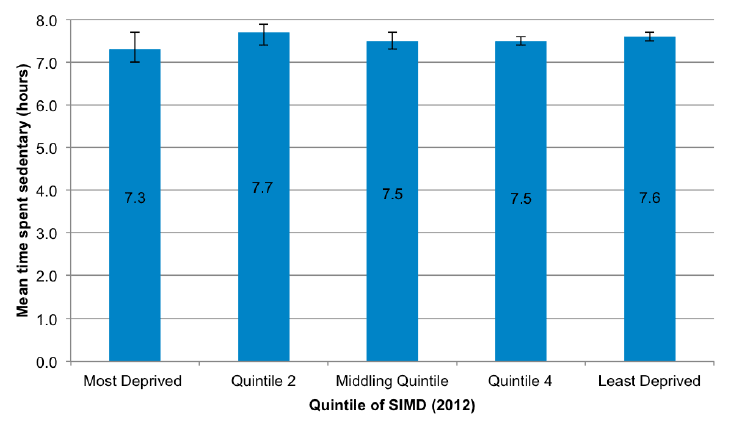
Error Bars: 95% Cl
3.1.2.2 MVPA - Area deprivation and Gender
Mean time spent in MVPA per quintile of the Scottish Index of Multiple Deprivation ( QSIMD) is summarised in Table 6. Data is further analysed as mean time spent per individual in MVPA during weekdays and weekend days per SIMD quintile. There were no statistically significant differences between quintiles of SIMD, either for all participants or for boys and girls separately. Participants in all quintiles (both boys and girls) engaged in, on average, more than 60 minutes of MVPA per day. Figure 2 shows a tendency for those in more deprived areas to engage in higher level of MVPA per day but there were no significant differences found. The pattern was similar for weekday and weekend day analyses.
Table 6 - MVPA by QSIMD
| MVPA in minutes | Girls | Boys | Overall |
|---|---|---|---|
| All days | |||
| Most deprived | 69.7 (59.6 - 79.7) | 80.8 (70.2 - 91.4) | 75.2 (67.7 - 82.7) |
| 2 | 65.8 (57.0 - 74.6) | 77.8 (71.6 - 84.0) | 71.8 (66.1 - 77.5) |
| 3 | 71.2 (64.8 - 77.6) | 75.2 (68.7 - 81.7) | 73.2 (68.7 - 77.8) |
| 4 | 65.3 (59.7 - 70.9) | 77.5 (71.5 - 83.5) | 71.4 (67.2 - 75.6) |
| Least deprived | 67.0 (63.3 - 70.7) | 76.2 (71.5 - 80.8) | 71.6 (68.3 - 74.9) |
| Weekdays | |||
| Most deprived | 73.1 (61.4 - 84.8) | 83.2 (73.2 - 93.3) | 78.2 (70.1 - 86.3) |
| 2 | 69.1 (60.1 - 77.3) | 84.5 (76.7 - 92.2) | 76.8 (71.1 - 82.5) |
| 3 | 73.3 (66.9 - 80.1) | 78.7 (72.1 - 85.3) | 76.0 (71.4 - 80.6) |
| 4 | 66.7 (61.9 - 71.7) | 79.8 (74.0 - 85.6) | 73.3 (69.2 - 77.3) |
| Least deprived | 68.9 (65.2 - 72.5) | 80.1 (75.1 - 84.8) | 74.4 (71.1 - 77.7) |
| Weekends | |||
| Most deprived | 60.1 (46.4 - 73.9) | 71.0 (54.2 - 87.9) | 65.6 (54.4 - 76.8) |
| 2 | 56.3 (41.4 - 71.3) | 62.6 (56.1 - 69.1) | 59.5 (51.4 - 67.5) |
| 3 | 64.0 (55.3 - 72.8) | 65.1 (55.0 - 75.3) | 64.6 (58.0 - 71.2) |
| 4 | 59.6 (50.0 - 69.2) | 72.0 (62.6 - 81.2) | 65.8 (58.6 - 72.9) |
| Least deprived | 60.7 (55.5 - 65.8) | 65.8 (60.1 - 71.6) | 63.2 (59.1 - 67.3) |
| Bases | |||
| Weighted | 84 | 81 | 164 |
| 81 | 59 | 139 | |
| 84 | 59 | 143 | |
| 86 | 80 | 166 | |
| 80 | 81 | 161 | |
| Unweighted | 35 | 29 | 64 |
| 55 | 44 | 99 | |
| 96 | 73 | 169 | |
| 110 | 97 | 207 | |
| 121 | 114 | 235 | |
No Statistically significant difference between quintile levels in 'Overall' 'Boys' and 'Girls'
Bonferroni correction applied
Significance testing adjusted for season of measurement, mean wear time, and number of valid days
Figures are Estimated Marginal Means (95% CI)
Figures rounded to 1 decimal place
Figure 2 - Mean time in MVPA per Quintile of deprivation rank ( SIMD) - All Days
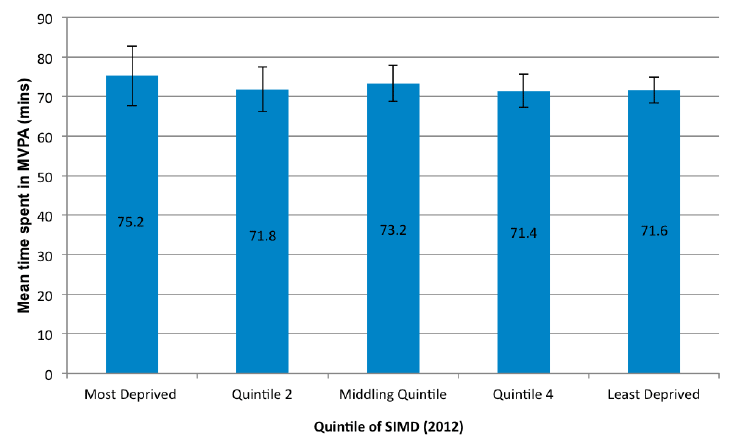
Error Bars: 95% Cl
3.1.3 Meeting the PA guidelines using 'Threshold' approach
Using a threshold approach to physical activity guidelines adherence, as described in section 3.3.2, only 12% of boys and 11% of girls meet the levels of activity recommended for their age group (that is at least 60 minutes in moderate to vigorous physical activity per day, across valid days (see Table 7 & Figure 3). No statistically significant differences existed between boys and girls.
Table 7 - Meeting the physical activity guidelines: Threshold approach
| 60 min MVPA per day | Girls | Boys | Total | P value |
|---|---|---|---|---|
| No | 371 | 317 | 688 | |
| (89.5%) | (88.4%) | (89.0%) | ||
| Yes | 44 | 42 | 85 | |
| (10.5%) | (11.6%) | (11.0%) | ||
| Total | 415 | 359 | 773 | 0.769 |
| (100%) | (100%) | (100%) | ||
| Bases | ||||
| Weighted | 415 | 359 | 773 | |
| Unweighted | 417 | 357 | 774 | |
Figure 3 - Meeting the guidelines according to threshold approach
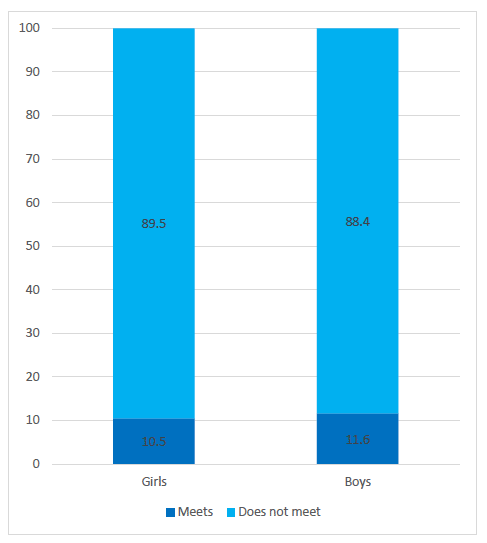
3.1.3.1 Guideline adherence by area deprivation - Threshold approach
There was no significant pattern by area deprivation for a higher likelihood of meeting the guidelines when using the 'threshold' approach to guideline adherence, as can be seen in Table 8 and Figure 4. A higher proportion of those in the most deprived areas met the guidelines, but the difference between quintiles was not statistically significant using a Pearson chi [2] test.
Table 8 - Meeting the physical activity guidelines: Threshold approach by QSIMD
| QSIMD | P value | |||||
|---|---|---|---|---|---|---|
| Meets guidelines | 1 (Most deprived) | 2 | 3 | 4 | 5 (Least deprived) | |
| No | 135 | 124 | 130 | 150 | 150 | |
| (82.0%) | (89.2%) | (90.8%) | (90.1%) | (93.1%) | ||
| Yes | 30 | 15 | 13 | 16 | 11 | 0.30 |
| (18.0%) | (10.8%) | (9.2%) | (9.9%) | (6.9%) | ||
| Bases | ||||||
| Weighted | 164 | 139 | 143 | 166 | 161 | |
| Unweighted | 64 | 99 | 169 | 207 | 235 | |
Figure 4 - Meeting the guidelines by Quintile of area deprivation ( SIMD) - Threshold approach
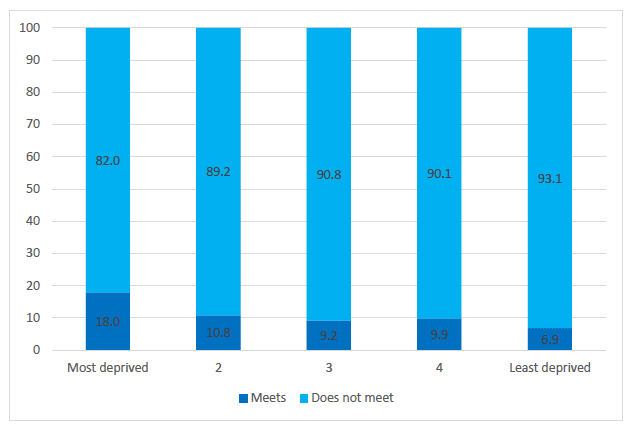
3.1.4 Meeting the PA guidelines using 'Averaging' approach
Another approach to look at adherence to guidelines is to obtain an average across all valid days with more than 1 min MVPA. That is, minutes spent in MVPA were averaged across valid days and participants with at least 60 mins per day were marked as meeting the guidelines. As shown in Table 9 and Figure 5, this approach substantially increases the proportion of children meeting the guidelines. Using this method, 60% of the children overall meet the recommended daily guidelines, and boys are significantly more likely to meet the guidelines than girls (69.4% vs. 52.4%, p <0.001).
Table 9 - Meeting the physical activity guidelines: Average approach
| Meets guidelines | Girls | Boys | Overall |
|---|---|---|---|
| No | 197 | 110 | 307 |
| (47.6%) | (30.6%) | (39.7%) | |
| Yes * | 217 | 249 | 466 |
| (52.4%) | (69.4%) | (60.3%) | |
| Total | 414 | 359 | 773 |
| (100%) | (100%) | (100%) | |
| Bases | |||
| Weighted | 415 | 359 | 773 |
| Unweighted | 417 | 357 | 774 |
* Statistically significant difference between girls and boys p<0.001
Figure 5 - Proportion meeting UK Chief Medical Officers PA guidelines using
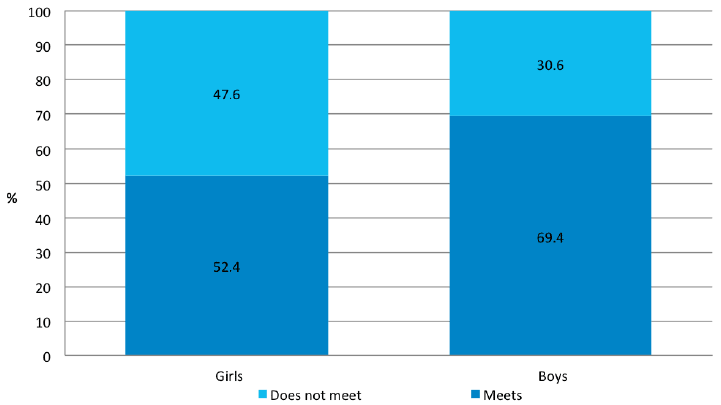
Averaging method
3.1.4.1 Guideline adherence by area deprivation - Averaging approach
There was no clear pattern by area deprivation in meeting the guidelines in one quintile or another when using the 'averaging' approach to guideline adherence, as can be seen in Table 10 and Figure 6. The difference between quintiles was not statistically significant using a Pearson chi [2] test.
Table 10 - Meeting the physical activity guidelines: Average approach by QSIMD
| QSIMD | P value | |||||
|---|---|---|---|---|---|---|
| Meets guidelines | 1 (Most deprived) | 2 | 3 | 4 | 5 (Least deprived) | |
| No | 64 | 48 | 60 | 68 | 68 | |
| (38.7%) | (34.3%) | (42.1%) | (40.7%) | (42.3%) | ||
| Yes | 100 | 91 | 83 | 98 | 93 | 0.811 |
| (61.3%) | (65.7%) | (57.9%) | (59.3%) | (57.7%) | ||
| Bases | ||||||
| Weighted | 164 | 139 | 143 | 166 | 161 | |
| Unweighted | 64 | 99 | 169 | 207 | 235 | |
Figure 6 - Meeting the guidelines by Quintile of area deprivation ( SIMD) - Averaging approach
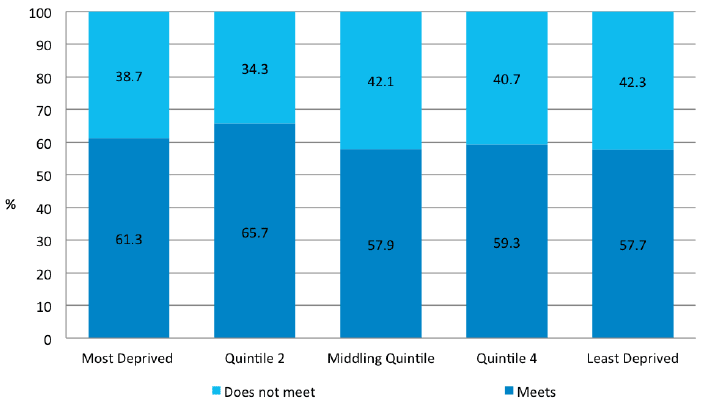
3.2 Self-reported physical activity
The first part of this section describes the ability of the PAQ-C to accurately measure physical activity levels in this age group using the accelerometer data as the reference (or criterion from which we can compare). This is followed by the gender and socio-economic analyses by PAQ-C score.
3.2.1 Validation of PAQ-C
As previously noted, the PAQ-C did not provide information that permitted direct comparison with the accelerometer output - the questionnaire does not provide time spent in MVPA or counts per minute. This meant that we could not measure the direct agreement between both measures ( i.e. do both measures produce identical outcomes). However, we were able to assess the ability of the PAQ-C to measure physical activity by assessing the monotonic/ linear relationship between the accelerometer (which we termed the criterion) and the questionnaire.
We tested the relationship between the two measures by way of the Pearson correlation coefficient (r), and the Spearman's rank order correlation coefficients (rho). The first analysis tested for a linear relationship between both methods ( i.e. the change in one variable being associated with a proportional change in the other variable); whereas the second analysis tested for a monotonic relationship ( i.e. both measures increase/decrease concurrently but not necessarily at the same rate) using ranked scores rather than raw data. The scatter plots that visually demonstrate these analyses can be seen in Appendix C; the scores presented in the following sections describe the strength of the relationship (0 = no relationship, +/-1 = perfect positive or negative monotonic/linear relationship).
3.2.1.1 Accelerometer and PAQ-C - MVPA
All graphs demonstrated a positive relationship between PAQ-C scores and time spent in MVPA (r = 0.39, rho=0.39). That is, as one of the measures increases, so does the other. This remains the case for both boys and girls when analysed separately, (girls: r=0.38, rho=0.34; boys: r=0.37, rho=0.39). The questionnaire was designed to measure activities within the MVPA range, and therefore should demonstrate a reasonable relationship with accelerometry derived MVPA; our results supported this. When we removed MVPA from the analysis and substituted three other physical activity outcomes (light, moderate, and vigorous activity), the correlations were weaker: light (r=0.14), moderate (r=0.30) and vigorous (r=0.37) and all were all lower than the r=0.39 reported for MVPA, indicating a stronger relationship between PAQ-C scores and accelerometry derived MVPA.
3.2.1.2 Accelerometer and PAQ-C - counts per minute ( CPM)
When analysing the relationship between PAQ-C scores and CPM (considered to represent 'overall' physical activity), a similar relationship, as with MVPA, was evident (r=0.36, rho=0.38) overall, and for boys (r=0.35, rho=0.36) and girls (r=0.37, rho=0.39). There was a strong positive correlation between MVPA and CPM (r=0.92) so the similarity between MVPA and CPM is expected. The 'counts per minute construct' integrates all activity data that has been recorded and includes physical activity of all intensities. It is therefore a useful measure to demonstrate 'total' PA of an individual. The PAQ-C questionnaire, in addition to MVPA, will inevitably capture time spent in light activity, and as such, the CPM construct was included to assess its relationship with PAQ-C scores.
3.2.1.3 PAQ-C scores between those who do and do not meet the CMO guidelines - Averaging method
We investigated whether PAQ-C detected differences in scores dependent on whether participants met, or did not meet the PA guidelines (using the averaging approach). As can be seen in Table 11 and Figure 7, PAQ-C scores were significantly higher in those participants who met the guidelines compared to those who didn't, further demonstrating the questionnaire's ability to discriminate between MVPA activity levels.
Table 11 PAQ-C score by those who meet and do not meet the physical activity guidelines: Average approach
| Average MVPA per day | Girls | Boys | Overall | ||
|---|---|---|---|---|---|
| Meets Guidelines | 3.23 (3.14-3.32) | 3.30 (3.19-3.41) | 3.26 (3.18-3.33) | ||
| Does not Meet Guidelines | 2.82 (2.71-2.94) | 2.90 (2.74-3.05) | 2.87 (2.78-2.96) | ||
| Bases | |||||
| Weighted | 361 | 317 | 678 | ||
| Unweighted | 375 | 321 | 696 | ||
| P value | <0.001 | <0.001 | <0.001 | ||
Statistically significant difference between those who meet and do not meet the CMO guidelines - overall, boys, and girls Significance testing adjusted for season of measurement. Figures are Estimated Marginal Means (95% CI). Figures are rounded to two decimal places
Figure 7 - PAQ-C scores as a function of guideline adherence grouping
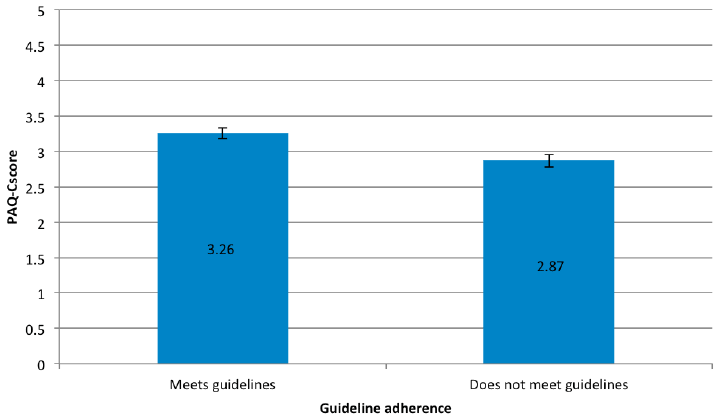
Error Bars: 95% Cl
3.2.2 PAQ-C scores - Overall, by Gender, and by SIMD
The previous section provides support on the use of the PAQ-C as an acceptable method to capture physical activity in children of this age group. We then used the questionnaire to investigate its ability to capture potential differences between boys and girls, and across quintiles of deprivation.
Boys scored higher on the PAQ-C than girls (3.19 vs. 3.05); this was statistically significant. There were no statistically significant differences for the mean PAQ-C scores between quintiles of SIMD (Table 12 and Figure 8). Both results were similar to those demonstrated by the accelerometers.
Table 12 PAQ-C score by QSIMD and Gender
| Girls | Boys | Overall | |
|---|---|---|---|
| PAQ-C scores * | 3.05 (2.99 - 3.12) | 3.19 (3.10 - 3.23) | 3.12 (3.06 - 3.19) |
| QSIMD | |||
| Most deprived | 3.07 (2.83 - 3.32) | 3.16 (2.83 - 3.49) | 3.12 (2.88 - 3.35) |
| 2 | 3.04 (2.89 - 3.18) | 3.27 (2.97 - 3.55) | 3.15 (2.98 - 3.33) |
| 3 | 3.12 (2.94 - 3.30) | 3.08 (2.92 - 3.22) | 3.10 (2.99 - 3.21) |
| 4 | 3.00 (2.84 - 3.10) | 3.23 (3.09 - 3.36) | 3.10 (3.00 - 3.20) |
| Least deprived | 3.07 (3.00 - 3.20) | 3.24 (3.13 - 3.34) | 3.16 (3.08 - 3.23) |
| Bases (Gender) | |||
| Weighted | 361 | 317 | 678 |
| Unweighted | 375 | 321 | 696 |
| Bases (Gender* SIMD) | |||
| Weighted | 64 | 74 | 138 |
| 77 | 48 | 124 | |
| 72 | 52 | 123 | |
| 77 | 72 | 149 | |
| 72 | 71 | 143 | |
| Unweighted | 29 | 23 | 52 |
| 52 | 39 | 91 | |
| 86 | 67 | 153 | |
| 99 | 90 | 189 | |
| 110 | 100 | 210 | |
Statistically significant difference between boys and girls: *p <0.05, Bonferroni correction applied,
Significance testing adjusted for season of measurement. Figures are Estimated Marginal Means (95% CI). Figures are rounded to nearest two decimal places
Figure 8 - PAQ-C scores by quintile of deprivation ( SIMD)
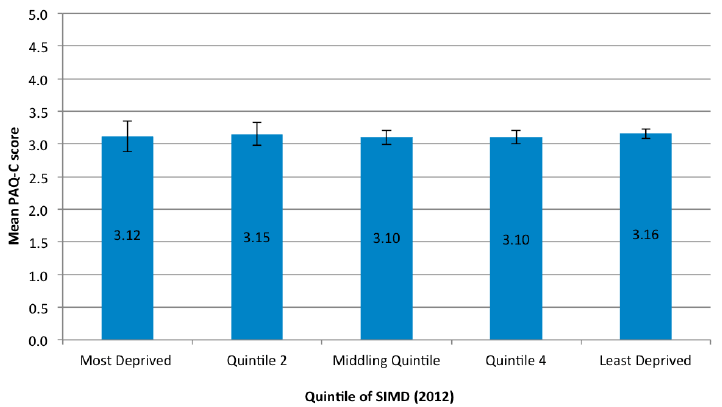
Error Bars: 95% Cl
Contact
Email: Ganka Mueller, socialresearch@gov.scot
Phone: 0300 244 4000 – Central Enquiry Unit
The Scottish Government
St Andrew's House
Regent Road
Edinburgh
EH1 3DG
There is a problem
Thanks for your feedback